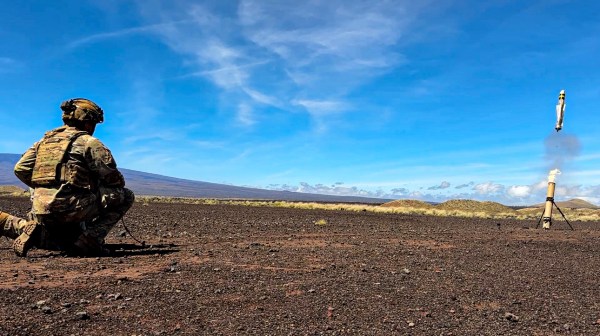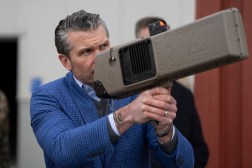Exclusive: Defense Secretary Austin unveils aims to push counter-UAS tech in Replicator 2.0

Pentagon leadership will accelerate high-volume production of technologies designed to detect, track and destroy enemy drones via “Replicator 2.0,” DefenseScoop has learned.
This development marks the first public report of the second capability focus area under the Replicator initiative — a high-profile effort that underpins the Defense Department’s multifaceted plan to deter China.
According to a memorandum signed by Defense Secretary Lloyd Austin on Sept. 27 and viewed by DefenseScoop ahead of publication Monday, the Pentagon “will tackle the warfighter priority of countering the threat posed by small uncrewed aerial systems (C-sUAS) to our most critical installations and force concentrations” under Replicator 2.0.
“The expectation is that Replicator 2 will assist with overcoming challenges we face in the areas of production capacity, technology innovation, authorities, policies, open system architecture and system integration, and force structure,” Austin wrote in the memo.
Austin has directed Deputy Defense Secretary Kathleen Hicks and Vice Chairman of the Joint Chiefs of Staff Adm. Christopher Grady to oversee the development of a Replicator 2.0 plan that will be proposed to Congress in the Pentagon’s budget request for fiscal 2026, according to the memo.
The Defense Department aims to field the C-sUAS systems selected through Replicator 2.0 within two years after lawmakers approve their funding, the secretary wrote.
A defense official declined to provide details regarding what systems, specific capabilities or quantities will be included in the Replicator 2.0 plan. However, the official noted the Pentagon will focus on fielding C-sUAS systems at locations both within and outside the continental United States.
The department sees opportunities to work with state governments, local communities and interagency partners to “burn down risk regarding domestic authorities needed for safe and secure base protection,” the official told DefenseScoop. As for overseas locations, the Pentagon will work with allies and partners to ensure the protection of military bases and surrounding communities, they added.
Hicks first launched Replicator as a key military technology and procurement modernization effort in August 2023.
At the time, she billed it as a strategic initiative to confront China’s massive, ongoing military buildup by incentivizing U.S. industrial production capacity and the Defense Department’s adoption of advanced warfare technologies en masse — through replicable processes — at a much faster pace than has been achieved before.
Tranches within the first capability focus area — Replicator 1.0 — broadly encompass the purchase and making of loitering munitions, and other technologies associated with what Hicks refers to as “all-domain attritable autonomous systems” (ADA2) to counter China’s anti-access/area-denial A2AD strategy by August 2025.
DefenseScoop has reported that the first two tranches of selections — dubbed Replicator 1.1 and 1.2 — include a variety of maritime and aerial drones and associated counter-drone assets selected for mass production.
Austin noted in the new memo that the Defense Department is “on track with the Initiative’s fielding plan for next summer,” adding that Replicator has “helped ignite our efforts to scale autonomous systems across the force more generally.”
Pentagon officials have secured roughly $500 million from Congress for fiscal 2024 to fund the first Replicator technology batches. The department has requested an additional $500 million for fiscal 2025.
Since Replicator’s inception, Hicks and other defense leaders have been expressly secretive about their full vision, select capabilities and concepts of operation that are foundational to realizing this effort, often citing security concerns.
Lawmakers, however, have also steadily questioned whether the department has allowed Congress and oversight bodies enough access to adequate information about the implementation of this initiative.
The defense official emphasized that Austin’s memo for Replicator 2.0 serves as an endorsement of the broader initiative, as well as a reflection of his commitment to delivering counter-unmanned aerial vehicle systems for warfighters.
“In marrying that commitment to the Replicator oversight and delivery model, the department will be well positioned to accelerate progress in this critical area,” the official said.
The forthcoming activities are envisioned to complement and advance “the significant C-sUAS work already underway in the Defense Department in delivering modular and mutually reinforcing solutions to sensing, AI-enabled decision support, and defeat capabilities appropriate to the range of environments in which those most critical installations and force concentrations operate,” the official added.
Doug Beck, director of the Defense Innovation Unit, will take the helm on Replicator 2.0 efforts in collaboration with Pentagon Under Secretary of Defense for Acquisition and Sustainment William LaPlante, who also serves as the department’s C-sUAS principal staff assistant, according to the memo.
Austin wrote that work under Replicator 2.0 will leverage efforts by the Counter Uncrewed Systems Warfighter (C-UXS) Senior Integration Group, which was established in March to identify capability gaps and potential technology solutions for countering threats posed by UAS.
The defense official told DefenseScoop that this team has since “been the body responsible for executing ‘fight tonight’ solutions to combat this threat.”
“Lessons learned from the C-UXS Senior Integration Group’s work regarding the ongoing threat posed by unmanned systems will help inform solutions for the Replicator 2 effort,” the official explained.
The defense official further pointed to real-world evolving conflicts in multiple regions abroad that they said “demonstrate the warfighter need for increased focus on” drone-disrupting technologies.
“The secretary has made clear that countering uncrewed assets is one of his top priorities. As a result of the Ukraine war and engagements in the Middle East, the department has learned a lot about the dynamic pace of the threat and the accelerated pace of emerging sUAS technology — all of which informed leadership’s thinking on where to focus Replicator 2,” they told DefenseScoop.






